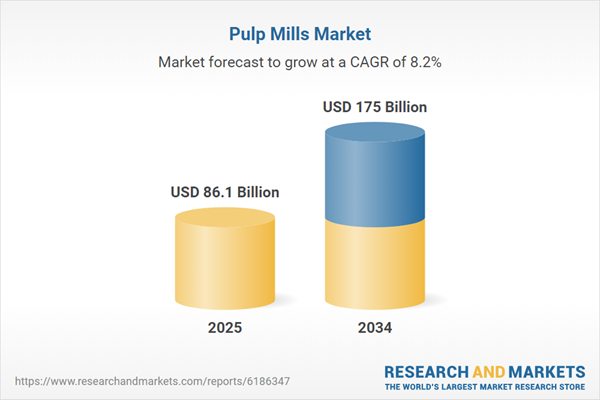Pulp Mills Market Overview
The pulp mills market forms the foundation of the global paper and packaging supply chain, processing wood chips and other fibrous materials into pulp - a critical raw material used in paper, tissue, and fiber-based packaging. Pulp mills typically fall into two main categories: chemical and mechanical, each offering different grades and qualities suited for specific applications. As sustainability and recyclability gain traction globally, pulp mills are adapting their operations to support increased production of recycled and non-wood pulp. The rise in demand for paper-based alternatives to plastic packaging, growing hygiene awareness, and expansion of e-commerce are significantly influencing market dynamics. Moreover, the integration of automation and advanced processing technologies is helping improve energy efficiency, reduce waste, and comply with tightening environmental regulations. With global demand for pulp expected to remain strong, especially in Asia-Pacific and Latin America, pulp mills are at the center of a major industrial transformation toward more circular and carbon-efficient operations.The pulp mills market experienced a steady uptick in capacity expansion, modernization, and sustainability initiatives. Several major players in North America and Europe announced investments to upgrade their pulp mills with carbon capture systems and water recycling technologies to align with ESG goals. The surge in demand for tissue and hygiene products post-pandemic continued to drive production volumes, while packaging grades of pulp saw significant growth, particularly in Asia. China accelerated domestic pulp mill development to reduce dependency on imports amid changing trade dynamics. In parallel, South American countries like Brazil and Chile remained key suppliers, investing in new mills with higher production capacity and better environmental performance. Technological upgrades also included the adoption of digital twin systems, remote diagnostics, and AI-assisted quality control to reduce variability and enhance productivity. While pulp prices fluctuated due to supply chain pressures and geopolitical issues, market sentiment remained positive, with long-term contracts offering some price stability.
The pulp mills market is expected to evolve rapidly, shaped by environmental mandates, digital transformation, and shifting global trade patterns. Bio-based pulping methods and enzymatic treatments will gain attention for their reduced chemical usage and lower carbon footprint. Mills will increasingly adopt smart process control systems to optimize chemical recovery, reduce water consumption, and enhance fiber yield. Demand for dissolving pulp, used in textiles and specialty chemicals, is also expected to rise, pushing mills to diversify product lines. Circular economy practices, such as integrating pulp production with bioenergy and lignin extraction, will create new revenue streams and improve mill sustainability. Additionally, emerging markets in Africa and Southeast Asia may begin developing localized pulp production capacity to support domestic paper and packaging industries. The future of the market hinges on how well producers can balance scale, sustainability, and agility in a fast-changing regulatory and consumer landscape.
Key Insights: Pulp Mills Market
- Integration of carbon capture, water reuse, and zero-liquid discharge systems is becoming common in new and upgraded pulp mills to meet ESG targets.
- Digital twin and AI-powered process optimization tools are improving operational efficiency, yield, and predictive maintenance in modern pulp mills.
- Increased demand for packaging and hygiene pulp grades is driving diversification in production lines and raw material sourcing strategies.
- Adoption of bio-refinery models is enabling pulp mills to extract multiple value-added products like lignin and biogas alongside core pulp output.
- Localization of pulp production in emerging markets is gaining traction to reduce reliance on imports and improve supply chain resilience.
- Rising demand for sustainable and biodegradable packaging is fueling investment in high-quality virgin and recycled pulp production facilities.
- Global expansion in hygiene and tissue paper consumption, especially in developing regions, is boosting pulp mill utilization rates.
- Stringent environmental regulations are driving modernization of existing mills with cleaner, more energy-efficient technologies.
- Growing interest in bio-based economies is encouraging pulp producers to integrate circular production models and diversify outputs.
- High capital investment, long development cycles, and regulatory hurdles for new mill construction or modernization can delay capacity expansion and limit smaller players from entering the market.
Pulp Mills Market Segmentation
By Source
- Wood Pulp or Virgin Fiber Pulp
- Non-Wood Pulp
- Recycled Pulp or De Inked Pulp
By Grade
- Mechanical
- Chemical
- Semi-Chemical,
By End User
- Packaging Manufacturers
- Publishers and Stationery Manufacturers
- Sanitary and Household Product Manufacturers.
Key Companies Analysed
- International Paper Company
- WestRock Company
- UPM-Kymmene Corporation
- Stora Enso Oyj
- Sappi Limited
- Domtar Corporation
- Asia Pulp & Paper (APP) Group
- Canfor Pulp Products Inc.
- Nippon Paper Industries Co., Ltd.
- Mercer International Inc.
Pulp Mills Market Analytics
The report employs rigorous tools, including Porter’s Five Forces, value chain mapping, and scenario-based modeling, to assess supply-demand dynamics. Cross-sector influences from parent, derived, and substitute markets are evaluated to identify risks and opportunities. Trade and pricing analytics provide an up-to-date view of international flows, including leading exporters, importers, and regional price trends.
Macroeconomic indicators, policy frameworks such as carbon pricing and energy security strategies, and evolving consumer behavior are considered in forecasting scenarios. Recent deal flows, partnerships, and technology innovations are incorporated to assess their impact on future market performance.Pulp Mills Market Competitive Intelligence
The competitive landscape is mapped through proprietary frameworks, profiling leading companies with details on business models, product portfolios, financial performance, and strategic initiatives. Key developments such as mergers & acquisitions, technology collaborations, investment inflows, and regional expansions are analyzed for their competitive impact. The report also identifies emerging players and innovative startups contributing to market disruption.
Regional insights highlight the most promising investment destinations, regulatory landscapes, and evolving partnerships across energy and industrial corridors.Countries Covered
- North America - Pulp Mills market data and outlook to 2034
- United States
- Canada
- Mexico
- Europe - Pulp Mills market data and outlook to 2034
- Germany
- United Kingdom
- France
- Italy
- Spain
- BeNeLux
- Russia
- Sweden
- Asia-Pacific - Pulp Mills market data and outlook to 2034
- China
- Japan
- India
- South Korea
- Australia
- Indonesia
- Malaysia
- Vietnam
- Middle East and Africa - Pulp Mills market data and outlook to 2034
- Saudi Arabia
- South Africa
- Iran
- UAE
- Egypt
- South and Central America - Pulp Mills market data and outlook to 2034
- Brazil
- Argentina
- Chile
- Peru
Research Methodology
This study combines primary inputs from industry experts across the Pulp Mills value chain with secondary data from associations, government publications, trade databases, and company disclosures. Proprietary modeling techniques, including data triangulation, statistical correlation, and scenario planning, are applied to deliver reliable market sizing and forecasting.Key Questions Addressed
- What is the current and forecast market size of the Pulp Mills industry at global, regional, and country levels?
- Which types, applications, and technologies present the highest growth potential?
- How are supply chains adapting to geopolitical and economic shocks?
- What role do policy frameworks, trade flows, and sustainability targets play in shaping demand?
- Who are the leading players, and how are their strategies evolving in the face of global uncertainty?
- Which regional “hotspots” and customer segments will outpace the market, and what go-to-market and partnership models best support entry and expansion?
- Where are the most investable opportunities - across technology roadmaps, sustainability-linked innovation, and M&A - and what is the best segment to invest over the next 3-5 years?
Your Key Takeaways from the Pulp Mills Market Report
- Global Pulp Mills market size and growth projections (CAGR), 2024-2034
- Impact of Russia-Ukraine, Israel-Palestine, and Hamas conflicts on Pulp Mills trade, costs, and supply chains
- Pulp Mills market size, share, and outlook across 5 regions and 27 countries, 2023-2034
- Pulp Mills market size, CAGR, and market share of key products, applications, and end-user verticals, 2023-2034
- Short- and long-term Pulp Mills market trends, drivers, restraints, and opportunities
- Porter’s Five Forces analysis, technological developments, and Pulp Mills supply chain analysis
- Pulp Mills trade analysis, Pulp Mills market price analysis, and Pulp Mills supply/demand dynamics
- Profiles of 5 leading companies - overview, key strategies, financials, and products
- Latest Pulp Mills market news and developments
Additional Support
With the purchase of this report, you will receive:- An updated PDF report and an MS Excel data workbook containing all market tables and figures for easy analysis.
- 7-day post-sale analyst support for clarifications and in-scope supplementary data, ensuring the deliverable aligns precisely with your requirements.
- Complimentary report update to incorporate the latest available data and the impact of recent market developments.
This product will be delivered within 1-3 business days.
Table of Contents
Companies Mentioned
- International Paper Company
- WestRock Company
- UPM-Kymmene Corporation
- Stora Enso Oyj
- Sappi Limited
- Domtar Corporation
- Asia Pulp & Paper (APP) Group
- Canfor Pulp Products Inc.
- Nippon Paper Industries Co. Ltd.
- Mercer International Inc.
Table Information
| Report Attribute | Details |
|---|---|
| No. of Pages | 160 |
| Published | October 2025 |
| Forecast Period | 2025 - 2034 |
| Estimated Market Value ( USD | $ 86.1 Billion |
| Forecasted Market Value ( USD | $ 175 Billion |
| Compound Annual Growth Rate | 8.2% |
| Regions Covered | Global |
| No. of Companies Mentioned | 10 |









